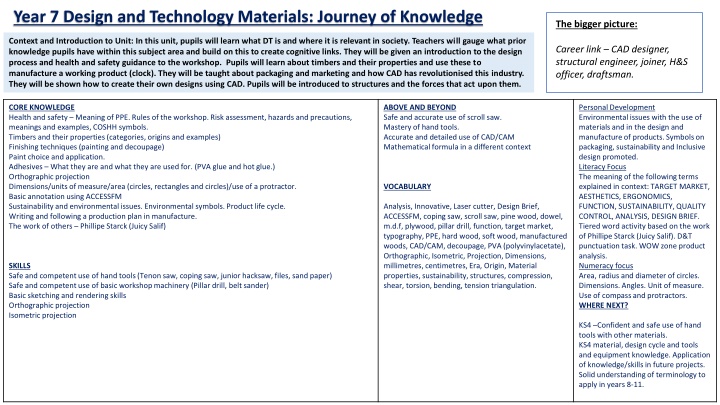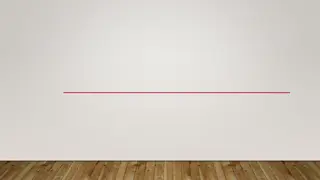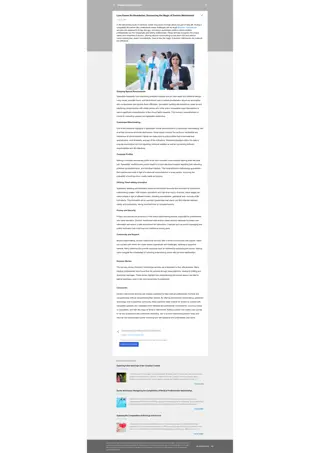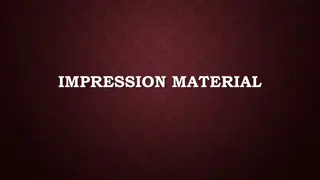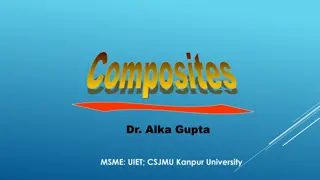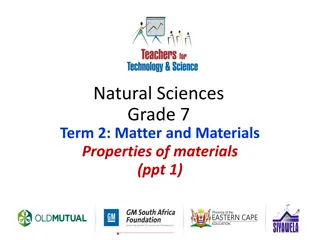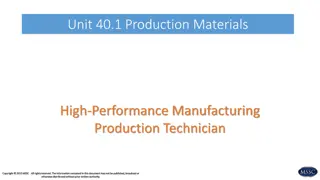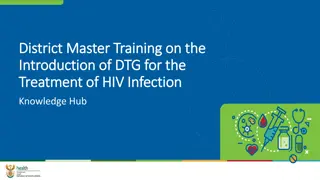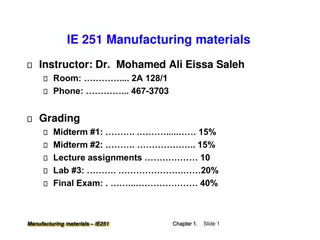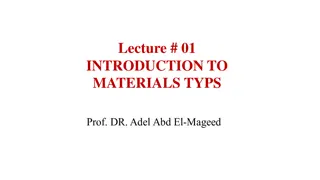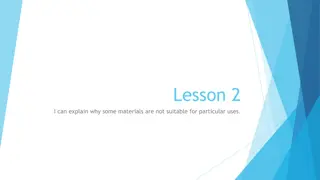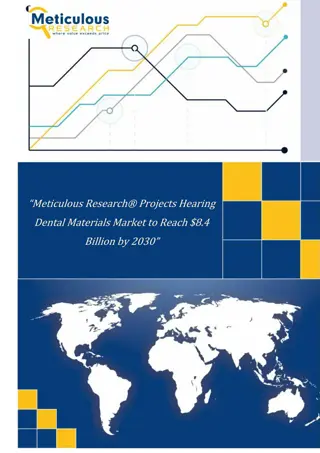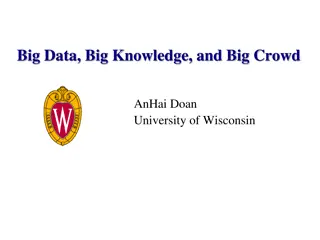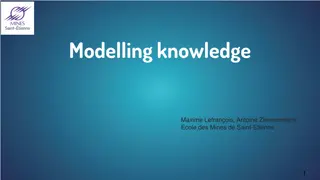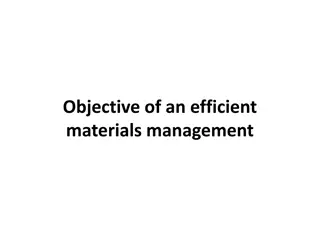Year 7 D&T Materials: Journey of Knowledge
This unit introduces pupils to Design and Technology, covering topics such as timbers, CAD, packaging, structures, and career paths in the field. Students will learn about materials, tools, processes, and develop skills for future projects.
Download Presentation

Please find below an Image/Link to download the presentation.
The content on the website is provided AS IS for your information and personal use only. It may not be sold, licensed, or shared on other websites without obtaining consent from the author.If you encounter any issues during the download, it is possible that the publisher has removed the file from their server.
You are allowed to download the files provided on this website for personal or commercial use, subject to the condition that they are used lawfully. All files are the property of their respective owners.
The content on the website is provided AS IS for your information and personal use only. It may not be sold, licensed, or shared on other websites without obtaining consent from the author.
E N D
Presentation Transcript
Year 7 Design and Technology Materials: Journey of Knowledge The bigger picture: Context and Introduction to Unit: In this unit, pupils will learn what DT is and where it is relevant in society. Teachers will gauge what prior knowledge pupils have within this subject area and build on this to create cognitive links. They will be given an introduction to the design process and health and safety guidance to the workshop. Pupils will learn about timbers and their properties and use these to manufacture a working product (clock). They will be taught about packaging and marketing and how CAD has revolutionised this industry. They will be shown how to create their own designs using CAD. Pupils will be introduced to structures and the forces that act upon them. Career link CAD designer, structural engineer, joiner, H&S officer, draftsman. CORE KNOWLEDGE Health and safety Meaning of PPE. Rules of the workshop. Risk assessment, hazards and precautions, meanings and examples, COSHH symbols. Timbers and their properties (categories, origins and examples) Finishing techniques (painting and decoupage) Paint choice and application. Adhesives What they are and what they are used for. (PVA glue and hot glue.) Orthographic projection Dimensions/units of measure/area (circles, rectangles and circles)/use of a protractor. Basic annotation using ACCESSFM Sustainability and environmental issues. Environmental symbols. Product life cycle. Writing and following a production plan in manufacture. The work of others Phillipe Starck (Juicy Salif) ABOVE AND BEYOND Safe and accurate use of scroll saw. Mastery of hand tools. Accurate and detailed use of CAD/CAM Mathematical formula in a different context Personal Development Environmental issues with the use of materials and in the design and manufacture of products. Symbols on packaging, sustainability and Inclusive design promoted. Literacy Focus The meaning of the following terms explained in context: TARGET MARKET, AESTHETICS, ERGONOMICS, FUNCTION, SUSTAINABILITY, QUALITY CONTROL, ANALYSIS, DESIGN BRIEF. Tiered word activity based on the work of Phillipe Starck (Juicy Salif). D&T punctuation task. WOW zone product analysis. Numeracy focus Area, radius and diameter of circles. Dimensions. Angles. Unit of measure. Use of compass and protractors. WHERE NEXT? VOCABULARY Analysis, Innovative, Laser cutter, Design Brief, ACCESSFM, coping saw, scroll saw, pine wood, dowel, m.d.f, plywood, pillar drill, function, target market, typography, PPE, hard wood, soft wood, manufactured woods, CAD/CAM, decoupage, PVA (polyvinylacetate), Orthographic, Isometric, Projection, Dimensions, millimetres, centimetres, Era, Origin, Material properties, sustainability, structures, compression, shear, torsion, bending, tension triangulation. SKILLS Safe and competent use of hand tools (Tenon saw, coping saw, junior hacksaw, files, sand paper) Safe and competent use of basic workshop machinery (Pillar drill, belt sander) Basic sketching and rendering skills Orthographic projection Isometric projection KS4 Confident and safe use of hand tools with other materials. KS4 material, design cycle and tools and equipment knowledge. Application of knowledge/skills in future projects. Solid understanding of terminology to apply in years 8-11.
Year 7 D&T Graphics: Journey of Knowledge The bigger picture: Context and Introduction to Unit: In this unit, pupils will learn what DT is and where it is relevant in society. Teachers will gauge what prior knowledge pupils have within this subject area and build on this to create cognitive links. They will be given an introduction to the design process and health and safety guidance to the workshop. Pupils will learn about timbers and their properties and use these to manufacture a working product (clock). They will be taught about packaging and marketing and how CAD has revolutionised this industry. They will be shown how to create their own designs using CAD. Pupils will be introduced to structures and the forces that act upon them. Career link CAD designer, structural engineer, joiner, H&S officer, draftsman. CORE KNOWLEDGE What a design brief is and how it fits into a design project. What a task analysis is and how it fits into a design project. Paper/Card and their properties (categories, origins and examples) Typography meaning and styles, functional and decorative type. Isometric projection Dimensions/units of measure/area NETS/Developments Basic annotation using ACCESSFM Target audience. Function of packaging including the meaning of symbols and development of NETs. Product analysis of packaging. ABOVE AND BEYOND Mastery of hand tools. Accurate and detailed use of CAD/CAM Mathematical formula in a different context Personal Development Environmental issues with the use of materials and in the design and manufacture of products. Symbols on packaging, sustainability and Inclusive design promoted. Designing for diversity. Literacy Focus The meaning of the following terms explained in context: TARGET MARKET, AESTHETICS, ERGONOMICS, FUNCTION, SUSTAINABILITY, QUALITY CONTROL, ANALYSIS, DESIGN BRIEF. WOW zone product analysis. Numeracy focus Dimensions. Angles. Unit of measure. VOCABULARY Analysis, Innovative, Laser cutter, Die cutter, Design Brief, ACCESSFM, function, target market, typography, PPE, CAD/CAM, decoupage, PVA (polyvinyacetate), Orthographic, Isometric, Projection, Dimensions, millimetres, centimetres, Era, Origin, Material properties, sustainability. WHERE NEXT? SKILLS Basic sketching and rendering skills Isometric projection Use of craft knives and scissors Use of render NET production and assembly KS4 Confident and safe use of hand tools with other materials. KS4 material, design cycle and tools and equipment knowledge. Application of knowledge/skills in future projects. Solid understanding of terminology to apply in years 8-11.
Year 7 Food Technology: Journey of Knowledge The bigger picture: Personal development opportunities. Career links. Nutritional therapist, food technologist, quality manager, catering, chef, baker/cake maker, business owner. Context and Introduction to Unit In this unit, pupils will learn what food technology is and when it is relevant in society. Teachers will gauge prior knowledge pupils have within the subject. They will be given an introduction to food technology, health and safety guidance to the kitchen and the importance of good hygiene. Pupils will learn about nutrition and Food types and their properties. They will learn about manufacturing food and special diets. They will also learn a number of cooking/ baking methods and apply these to producing a range of food products. CORE KNOWLEDGE Health and safety- rules, routines, risk assessment, hazards and precautions, hygiene Bacteria, causes, prevention, factors that makes bacteria multiply (Moisture, time, food, oxygen, temp.) Product analysis of food products Nutrition Macro and micro nutrients. Protein, Carbohydrates, Fats, Fibre, Vitamins and Minerals) Food packaging and labelling, symbols including nutritional values. Key terminology (See Vocab list) Manufacturing food See skills list. Storing/cooking food safely. (fridge, Freezer and ambient foods) Food miles/ seasonal foods ABOVE AND BEYOND Personal Development Rse Healthy lifestyle, Food miles, packing and its impact on the environment. Symbols on packaging, reading food labels. Independently working through methods Recipe adaptations for special diets. Acceleration tasks. Literacy Focus Word rich meanings Comprehension task VOCABULARY Ingredients, combine, method, hygiene, nutrition, properties, manufacturing, diets, bacteria, creaming, rubbing, chopping, origin, evaluation, blend, mix. Appearance, aesthetics, aroma, texture, protect, preserve, promote. SKILLS Safe and compliant use of the kitchen oven/grill/hob Use of basic kitchen equipment Cleaning and effectively removing bacteria Combining ingredients Weighing and measuring Methods such as; all in one, creaming, rubbing, melting use of the hob/oven/ grill Chopping skills (bridge and claw) Numeracy Focus Measuring in ml, grams, weighing out, portion sizes, dividing. WHERE NEXT: Food Products Wrap pizza, fruit salad, Flap Jacks, fruit crumble, fairy cakes. Food adaptation, advanced cooking methods and introduction to careers in H&C and food preparation.
Year 8 Design and Technology/Textiles: Journey of Knowledge The bigger picture: Context and Introduction to Unit: In this unit, pupils will build upon prior knowledge pupils have learned within this subject area in year 7 . They will be given an introduction to polymers and textiles as new learning and consolidate health and safety guidance to the workshop. Pupils will learn about different types of circuits and their uses. They will be taught about key stages in the design cycle including the design brief, specification and the importance of designing for a client. They will consolidate their CAD work and how this can be used with different materials and software. Career link CAD designer, structural engineer, joiner, H&S officer, draftsman. CORE KNOWLEDGE Textiles (origins/ categories) Natural (cotton, felt, wool and coir) and Synthetic (acrylic, felt and polyester). Blended fabrics. (Polycotton) Textile properties and examples including uses and manufacturing techniques. (Strength, absorbency, technical textiles conductivity) Designing for a client difference between user and client and their needs when designing products. Writing a design Brief how to solve everyday problems through design. Biomimicry What it is and how designers use it including examples. How to write a meaningful product analysis, design specification and evaluation using ACCESSFM. Design sketching including speed designing and presenting design sketches effectively. How to test a product effectively within the iterative design process. The work of Jon Burgerman. ABOVE AND BEYOND Production processes used in the manufacture of textiles. Knowledge of machinery settings when using CAM Mathematical formulae Use of knowledge in the design process. Cross curricular linking STEAM subjects, Geography, English and History. Personal Development Discussions regarding the relationships between user, client, designer and manufacturer. Inclusive design promoted. Use of nature to inspire products. The work of Jon Burgerman monsters. Literacy Focus CAD/CAM WOW zone task Tired words Pop Artist 3D work. Area of circles Basic electronic terms and application Discussion of key terminology: Client, customer, profile, profession, radius and diameter. SKILLS Research Sewing Textiles decoration Specification writing Evaluative writing VOCABULARY User, client, Die cutter, Design Brief, ACCESSFM, Sewing machine, heat press, synthetic, natural fibres, blended fibres, acrylic, nylon, thermoplastic, thermosetting plastic, CAD/CAM, engraved, sustainability, textile, origin, evaluation, specification, : customer, profile, profession. Numeracy focus Area of rectangle, triangles and circles. Co-ordinates when using CADCAM. Units of measure in workshop and CAD. Pie Charts. WHERE NEXT? Confident and safe use of hand tools with other materials. KS4 material, design cycle and tools and equipment knowledge. KS3
Year 8 Design and Technology: Journey of Knowledge The bigger picture: Context and Introduction to Unit: In this unit, pupils will build upon prior knowledge pupils have learned within this subject area in year 7 . They will be given an introduction to polymers and textiles as new learning and consolidate health and safety guidance to the workshop. Pupils will learn about different types of circuits and their uses. They will be taught about key stages in the design cycle including the design brief, specification and the importance of designing for a client. They will consolidate their CAD work and how this can be used with different materials and software. Career link CAD designer, structural engineer, joiner, H&S officer, draftsman. CORE KNOWLEDGE CAD/CAM - advantages and disadvantages, knowledge of hardware and software to make basic products. Polymers (origins/ categories ( difference between thermosets and thermoforming)/ distillation process), examples of polymers, polymer structure and environmental issues with using plastic for products. Polymer properties and production processes including vacuum forming and blow moulding. How to produce effective research including key iconic designers. What is a circuit Difference between series and parallel circuits Mechanisms Scales of production and planning manufacture. Anthropometrics AND ERGONOMICS Electronics basic circuits (series and parallel differences), components and symbols. Understand the meaning of the 6Rs and their use in responsible design. How to test a product effectively within the iterative design process. ABOVE AND BEYOND Molecular structure of polymers Knowledge of machinery settings when using CAM Mathematical formulae Use of knowledge in the design process. Cross curricular linking STEAM subjects, Geography, English and History. Personal Development Discussions regarding the relationships between user, client, designer and manufacturer. Inclusive design promoted. Use of nature to inspire products. Literacy Focus CAD/CAM WOW zone task Tired words Pop Artist 3D work. Area of circles Basic electronic terms and application Discussion of key terminology: Client, customer, profile, profession, radius and diameter. VOCABULARY linear, reciprocating, oscillating, rotary, User, client, Laser cutter, Design Brief, ACCESSFM, coping saw, scroll saw, acrylic, polypropylene, nylon, pillar drill, series/parallel circuits, thermoplastic, thermosetting plastic, CAD/CAM, engraved, sustainability, formulae, mechanism, textile, origin, evaluation, specification, : Client, customer, profile, profession, radius, diameter, fractional distillation, formaldehyde, resin, forming, extruding, vacuum forming, blow moulding, injection moulding. SKILLS Research Vinyl application Use of 2D design and Robo-master software (CAD) Safe and accurate use of tools, machinery and equipment with Acrylic Competent use of the laser cutter. Numeracy focus Area of rectangle, triangles and circles. Co-ordinates when using CADCAM. Units of measure in workshop and CAD. Pie Charts. WHERE NEXT? Confident and safe use of hand tools with other materials. KS4 material, design cycle and tools and equipment knowledge. KS3
Year 8 Food Technology: Journey of Knowledge The bigger picture: Personal development opportunities. Career links. Nutritional therapist, food technologist, quality manager, catering, chef, food vender, business owner. Context and Introduction to Unit In this unit, pupils will learn what food technology is and when it is relevant in society. Teachers will gauge prior knowledge pupils have within the subject. They will be given an introduction to health and safety guidance to the kitchen and the importance of good hygiene. Pupils will learn about nutrition and Food types and their properties. They will learn about manufacturing food and special diets. They will also learn a number of cooking/ baking methods and apply these to producing a range of food products. CORE KNOWLEDGE Health and safety- rules, risk assessment, hazards and precautions, hygiene, PPE. Bacteria, causes, prevention and Nutrition Micro/macro nutrients and the Eatwell plate/guide. Food types/properties and functions of ingredients Recipe adaptations Designing food products Manufacturing food and Production methods Sensory Evaluation of food products Special diets Storing/cooking food safely ABOVE AND BEYOND Personal Development Rse Food miles, packing and its impact on the environment. Symbols on packaging, reading food labels. Cultural influences on food products. Independently working through methods Recipe adaptations for special diets Investigating own design ideas. Acceleration tasks Literacy Focus Word rich meanings SKILLS Safe and compliant use of the kitchen oven/grill/hob Use of basic kitchen equipment Cleaning and effectively removing bacteria Combining ingredients Weighing and measuring Methods such as; all in one, creaming, rubbing, kneading, boiling, blending Chopping skills recipe adaptations Sensory evaluations Numeracy Focus Measuring in ml, grams, weighing out, portion sizes, dividing. VOCABULARY Ingredients, combine, method, hygiene, nutrition, properties, manufacturing, diets, bacteria, micro, macro, creaming, rubbing, chopping, kneading, adaptations, evaluation, sensory, blend, mix, separate, combine, seasonal, balanced, evaluation, quality control, edible, casing, snack foods, eatwell guide. WHERE NEXT: Year 9 Food Products Sausage rolls, shortcrust pastry, jam parcels, fajitas, muffins
Year 9 Design and Technology: Journey of Knowledge The bigger picture: In this unit, pupils will build a deeper knowledge of several different materials used in the design and manufacture of products. They will learn about renewable and non-renewable energy sources and the impact that they all have on our environment. Pupils will have the opportunity to use practical equipment in focused practical tasks that will encompass the theory learned in the unit as well as key literacy and numeracy skills. The knowledge gained will allow pupils to make informed choices when choosing their option subjects. Career links Sustainability when manufacturing Environmental issues CORE KNOWLEDGE SMART and modern materials and their properties, meaning of property terminology Paper and boards and their properties, meaning of property terminology Mechanisms Metals and properties - categories, processes, advantages and disadvantages, examples Timbers and their properties - categories, processes, advantages and disadvantages, examples. Textiles and their properties - categories, processes, advantages and disadvantages, examples Polymers and their properties - categories, processes, advantages and disadvantages, examples (All done as home learning using knowledge journeys) Sustainability 6Rs, symbols, LCA, renewable and non-renewable Production Processes including laser cutting, lamination and 3D printing Adhesives PVA glue. How to produce perspective drawing (1 and 2 point) isometric, orthographic and oblique projections How to effectively evaluate a product. Designers and their work. (Dyson, Starck, Westwood and Rams) Scales of production and planning one-off, batch, mass, continuous Advantages and disadvantages of technology in manufacturing ABOVE AND BEYOND Molecular structure of polymers Knowledge of machinery settings when using CAM Mathematical formulae Use of knowledge in the design process. Cross curricular linking STEAM subjects, Geography, English and History. Personal Development Discussions regarding the relationships between user, client, designer and manufacturer. Inclusive design promoted. Use of nature to inspire products. RSE Literacy Focus Renewable /non-renewable resources Wind, biomass, solar, tidal, hydro- electric VOCABULARY Carbon footprint, sustainability, analysis, life cycle analysis, 6Rs, planned obsolescence, flexible manufacturing, lean manufacturing, just in time, production scales, biodegradable, thermoforming, thermosetting polymers, hardwood, softwood, manufactured boards, alloy, ferrous, non-ferrous, stimulus, rigid, GSM, deciduous, coniferous, absorbent, natural, synthetic, ductile, malleable, Material, properties, absorbency, density, fusibility, electrical conductivity, thermal conductivity, physical / working properties, strength, hardness, toughness, malleability, ductility, elasticity, GSM, microns, evergreen, felling, veneer, furnace, Bauxite, electrolysis, ferrite, carbon, additive, oxidise, Verdigris, patina, galvanise, VOCs, yarn, warp, weft, selvedge, plain weave, Power, coal, gas, oil, fossil fuel, nuclear, wind, solar, tidal, hydroelectric, biomass, renewable energy, Numeracy focus Area, pie chart, cutting list, percentages WHERE NEXT? More knowledge of D&T KS4 expectations with rigorous content to learn inforing option choices SKILLS Modelling from card Safe and controlled use of tools and equipment Using adhesives Orthographic projection Painting Vinyl application Wood joints (mini box?) small focused practical tasks keyring/box/net etc. Sketching and presenting design ideas
Year 9 3D Design: Journey of Knowledge The bigger picture: Context and Introduction to Unit: 3D design (Keith Haring) In this unit pupils will follow the 3D design route and assessment objectives for art and design. They will produce a mini project based on the work of Keith Haring. Pupils will build upon their knowledge of different materials used in the design and manufacture of installations. They will learn about mark making, manufacturing processes and different finishes used on 3D artwork. Pupils will have the opportunity to use practical equipment in focused practical tasks that will encompass the theory learned in the unit as well as key literacy and numeracy skills. The knowledge gained will allow pupils to make informed choices when choosing their option subjects. Career link 3D artist, Set designer, Installation artist, Design critic. CORE KNOWLEDGE The meaning of Abstract and the key characteristics of the movement. 3D techniques including layering Experimentation with different media including acrylic paint and corrugated card. Keith Haring and characteristics of his work Mark making patterns The meaning of Neo- expressionism and some key characteristic of the movement. (Neo-Expressionism comprised a varied assemblage of young artists who had returned to portraying the human body and other recognizable objects, in reaction to the remote, introverted, highly intellectualized abstract art production of the 1970s) The meaning of Pop Art and Contemporary Art and some key characteristic of the movements. ABOVE AND BEYOND Knowledge of machinery settings when using CAM Mathematical formulae Use of knowledge in the design process. Cross curricular linking STEAM subjects, Geography, English and History. Personal Development RSE Keith Haring LGBTQA+ Active lifestyle logo link. Literacy Focus Wow Zone activity based on Keith Haring biography and work. SKILLS Modelling from card Safe and controlled use of tools and equipment Using adhesives Painting Vinyl application Use of craft knives safety and application Use of coping saws. Mark making using mixed media Drawing skills with pencil, pen and other equipment Drawing for purpose Engraving The use of Watercolour The use of acrylic paint on different materials VOCABULARY Mixed media, experimentation, abstract, printmaker, surrealism, engraving, abstract, expression, era, founded, significant, refine, free-flowing, blend, construct, experimentation, textiles, installation, movement. Numeracy focus Unit of measure. WHERE NEXT? Pupils have a fuller knowledge of the 3D design course and can make informed choices for their KS4 pathway
Year 9 Food Technology: Journey of Knowledge The bigger picture: Personal development opportunities. Career links. Nutritional therapist, food technologist, quality manager, catering, chef, hospitality industry, business owner Context and Introduction to Unit In this unit, pupils will learn what food technology is and when it is relevant in society. Teachers will gauge prior knowledge pupils have within the subject. They will be given an introduction to food technology, health and safety guidance to the kitchen and the importance of good hygiene. Pupils will learn about nutrition and Food types and their properties. They will learn about manufacturing food and special diets. They will also learn a number of cooking/ baking methods and apply these to producing a range of food products. They will learn about different cultures and how foods are used and celebrated within different cultures. CORE KNOWLEDGE Health and safety- rules, risk assessment, hazards and precautions, hygiene Bacteria, causes, prevention and practical awareness within cooking Nutrition Micro/macro nutrients and nutritional values Properties and functions of ingredients Manufacturing food Special diets Storing/cooking food safely Cultural influences Food miles Star diagram product analysis SKILLS Safe and compliant use of the kitchen oven/grill/hob Use of basic kitchen equipment Cleaning and effectively removing bacteria Combining ingredients Weighing and measuring Methods such as; all in one, creaming, rubbing, kneading Chopping skills Recipe adaptations Sensory evaluation and analysis Production methods Time plans Independent research Food Products Shortcrust pastry, cheese and onion triangles, bread dough, pizzas, fruit plait. ABOVE AND BEYOND Personal Development Rse Healthy lifestyle, Food miles, packing and its impact on the environment. Symbols on packaging, reading food labels. Ethical choices, cultural choices. Independently working through methods Recipe adaptations for special diets Developing own recipes from scratch Producing time plans for individual tasks Acceleration tasks Understanding multicultural foods brief and key terms Using a production plan to risk assess Sensory analysis for specific dietary requirements Literacy Focus Word rich meanings Comprehension task Numeracy Focus VOCABULARY Multi-cultural foods, Ingredients, combine, method, hygiene, nutrition, properties, manufacturing, diets, bacteria, micro, macro, creaming, rubbing, chopping, origin, kneading, adaptations, evaluation, sensory, blend, mix, separate, culture, aroma, texture, sensory, taste, palatable Measuring in ml, grams, weighing out, portion sizes, dividing. WHERE NEXT: KS4 Hospitality and Catering
